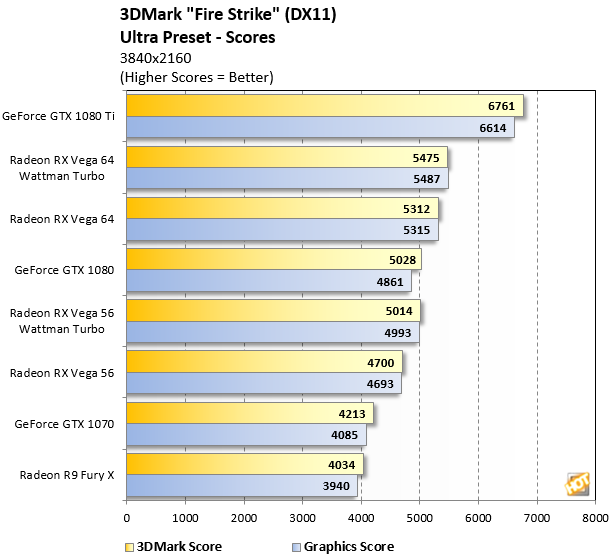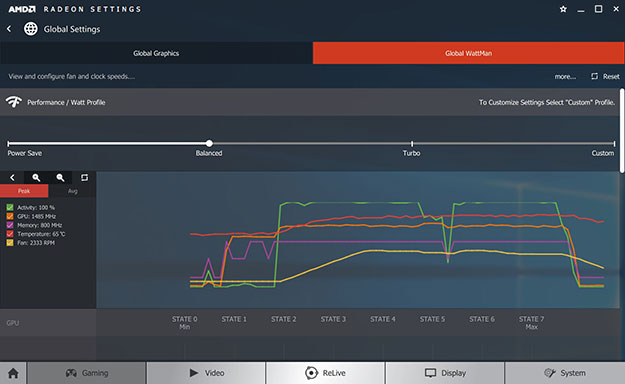Radeon RX Vega 64 And RX Vega 56 Review: AMD Back In High-End Graphics
We also spent a little time tuning and checking power numbers with these new Radeon RX Vega cards, to see what kind of additional performance we could squeeze out of them. Like previous-gen Polaris-based Radeon cards, when boosting, frequencies and voltages scale upwards (power and temperature permitting) based on the GPU's workload at the time. With the WattMan tool built into AMD's drivers, however, users have the ability to manually alter frequencies and voltages on a per-voltage step (or state) basis and the power targets can be changed as well. Wattman also includes a new preset slider for Power Saver, Balanced, Turbo and Custom settings on Vega.
Unfortunately, due to time constraints and the fact that overclocking with Vega right now is limited -- along with a new driver drop hitting just hours before launch that enabled some level of consistent tuning -- we didn't get enough time to explore the overclocking and power ranges of Vega. As such, we were only able to experiment with AMD's new Wattman Performance per Watt profile slider, adjusting between the default Balanced mode, as well as Turbo, and Power Save.
As you can see in the screen shots, at the Balanced slider setting, Radeon RX Vega 64 tops out at about a 1534MHz GPU clock and 76ºC core temp, with 1980MHz memory (Double Data-Rate - 945MHz x 2). Radeon RX Vega 56 drops in at a 1485MHz GPU clock, 1600MHz on its memory interface, and with a 65ºC GPU core temp. These readings were taken after multiple benchmark runs in Mordor at 1440p Ultra settings.
But what happens when you pull that slider up to Turbo or down to Power Save? Let's look...
Balanced, Turbo, And Power Save - Finding The Sweet Spot


|
|
|

As the saying goes, a picture is worth a thousand words. Radeon RX Vega 64, at its default, out-the-box Balanced mode setting draws nearly 40 Watts more power under load than a GeForce GTX 1080 Ti, a card that carries 3MB of additional frame buffer memory and delivers a lot more graphics horsepower. The Radeon Vega 56 is a lot more power-efficient and as you can see, it actually drew less power than the system config with the AMD Fiji-based Radeon R9 Fury X, a card that carries 4GB less HBM frame buffer and is some 15 - 20 percent slower. This speaks to Vega's performance-per-watt gains with generational improvements for AMD, but unfortunately, compared to NVIDIA GeForce 10 silicon, Vega still looks voraciously power-hungry.
Of note, on Power Save mode, there are some really nice power savings (and nicer acoustics to be had) without much performance sacrifice. If you scan the Power Save frame rates and scores again above, and do the math, you'll see it's worth it.
Radeon RX Vega Temps And Acoustics -
It's Not Quite Fermi But...
There's really no other way to state this, so we're just going to come out with it. Compared to competitive NVIDIA GeForce 10 cards in the same segment or even NVIDIA's most powerful consumer cards, the Radeon RX Vega 64 and RX Vega 56 are loud. They're not crazy, hair dryer loud, but louder than we're used to hearing lately, whether it be versus a GTX 1080 Ti or a Radeon RX 580 strapped in a pushing the pixels. On average, both cards push about 50db (Vega 56) to 53db (Vega 64) on an open air test bench with a decibel meter positioned about about 6 - 8 inches away from the back of the cards. Drop these cards into a case and things get quieter for sure, but their fans will tend to stay in the higher ranges with more challenging thermal constraints. The Power Saver setting on either card can pull them down another 2 - 4db, in addition to taming thermal build-up in general. Turbo settings do what you might expect, things get a little (not a lot) louder.
Thermally, the cards also get pretty warm, with Vega 64 measuring about 150ºF on its backplate at its hottest spot and Vega 56 toasting at about 140ºF. These temps aren't too alarming, however. And again, monitoring GPU temps, we observed relatively nominal core temperatures. Still, these cards do push a bunch of heat out from their rear IO plate when stressed.
In short, Radeon RX Vega, in its current incarnation, needs air flow and is simply louder than anything we've tested in the same performance category currently. We wouldn't say it's obnoxiously hot or loud, but yes, it's a bit of a feisty beast.







